Click below to jump to an article of interest.
Solar Wind Studies
Particles near Sun point to distant solar wind structures
Using data from NASA’s Parker Solar Probe (PSP), an SwRI-led team identified low-energy particles lurking near the Sun that likely originated from solar wind interactions well beyond Earth orbit. The discovery explains the origin of mysterious particles accelerated by interactions between slow- and fast-moving regions of the solar wind. PSP is venturing closer to the Sun than any previous probe, carrying hardware SwRI helped develop. Scientists are probing the enigmatic features of the Sun to answer many questions, including how to protect space travelers and technology from the radiation associated with solar events.
“Our main goal is to determine the acceleration mechanisms that create and transport dangerous high-energy particles from the solar atmosphere into the solar system, including the near-Earth environment,” said Dr. Mihir Desai, a mission co-investigator on the Integrated Science Investigation of the Sun (IS☉IS) instrument suite. IS☉IS consists of two instruments, Energetic Particle Instrument-High (EPI-Hi) and Energetic Particle Instrument-Low (EPI-Lo). “With EPI-Lo, we were able to measure extremely low-energy particles unexpectedly close to the solar environment.”
Roughly every 11 years, when solar activity reaches a lull, the Sun’s equatorial regions emit slower solar wind streams, traveling around 1 million miles per hour, while the poles spew faster streams, traveling twice as fast. When the fast-moving streams overtake slower streams, turbulent corotating interaction regions are formed, producing shock waves and accelerated particles.
“The presence of low-energy particles near the Sun are the smoking gun pointing to interactions between slow- and fast-moving regions of the solar wind that accelerate high-energy particles from beyond the orbit of Earth,” Desai said. “Some of those travel back toward the Sun, slowing against the tide of the outpouring solar wind but still retaining surprisingly high energies.”
For more information, go to Heliophysics.
Supersonic stream slows with distance
NASA’s New Horizons spacecraft is providing important new insights about some of the farthest reaches of space ever explored. In a paper recently published in The Astrophysical Journal, an SwRI-led team detailed how the solar wind — the supersonic stream of charged particles blown out by the Sun — slows at increasing distances from the Sun.
“Previously, only the Pioneer and Voyager missions had explored the outer solar system,” said SwRI’s Dr. Heather Elliott, deputy principal investigator of the Solar Wind Around Pluto (SWAP) instrument and lead author of the paper. “Now, New Horizons is looking at the outer reaches with more modern technology, such as the SWAP instrument. Our Sun’s influence on the space environment extends well beyond the outer planets, and SWAP is revealing how that environment changes with distance.”

Courtesy of NASA/IBEX/Adler Planetarium
New SWAP research shows the solar wind begins to slow as it approaches Jupiter orbit and continues to slow as it moves through the solar system and picks up interstellar material. The solar wind becomes slower than the speed of sound at the termination shock and continues to slow until it reaches the heliopause, where the interstellar medium and solar wind pressures balance. This is the boundary of the heliosphere, or the sphere of the Sun’s influence.
The solar wind fills a bubble-like region of space encompassing our solar system, known as the heliosphere. From aboard New Horizons, SWAP collects detailed, daily measurements of the solar wind as well as other key components called “interstellar pickup ions” in the outer heliosphere. Interstellar pickup ions are created when neutral material from interstellar space enters the solar system and becomes ionized by sunlight or by solar wind ion interactions.
The SWAP team measured solar wind speeds at 21 to 42 astronomical units (one AU equals the distance between the Sun and the Earth). These measurements were compared to those made by spacecraft at 1 AU. By 21 AU, SWAP detected an apparent slowing of the solar wind in response to interstellar material pickup. When New Horizons traveled beyond Pluto, between 33 and 42 AU, the solar wind measured 6-7% slower than at the 1 AU distance, confirming the effect.
For more information, go to: http://pluto.jhuapl.edu/.
SwRI Device Tested Onboard Blue Origin Vehicle
SwRI recently tested a device designed to deliver liquid propellant to a rocket engine on a suborbital flight aboard Blue Origin’s New Shepard vehicle. SwRI engineers and NASA’s Glenn Research Center developed the tapered liquid acquisition device (LAD) to prevent potentially dangerous vapor bubbles from being transferred from the fuel tank to the engine. NASA has provided an additional \$500,000 in funding for two additional launch evaluations.
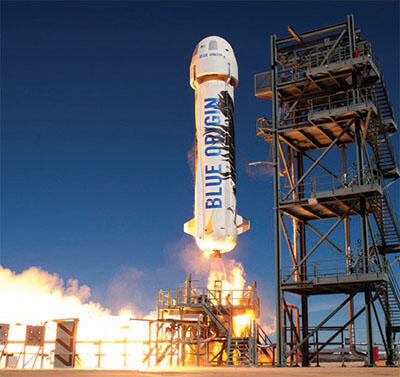
Courtesy of Blue Origin
“On a long space mission, large amounts of fuel must be stored at low temperatures for transfer to the rocket engine as needed,” said Kevin Supak, a senior research engineer at SwRI and the project’s principal investigator. “Current LADs have straight channels that cannot manage internal vapor bubbles.”
Through propellant boil-off, vapor bubbles can hinder liquid propellant from transferring to other tanks or damage rocket engines during ignition. Supak, along with SwRI engineers Dr. Amy McCleney and Steve Green, are evaluating the device, which has a tapered channel that passively removes bubbles through surface tension. The idea originated with a joint research effort between SwRI and NASA in the late 1990s and early 2000s to develop cryogenic fluid management capabilities.
“The device had never been tested in long-duration microgravity because it has historically been too expensive,” Supak said. “Blue Origin is providing access to inexpensive, high-quality microgravity for research.”
New Shepard launches from Blue Origin’s test site near Van Horn, Texas. Future flight evaluations will focus on larger, more realistic versions of the bubble-free LAD.
\$25 Million for EPA Vehicle Fuel, Emissions Studies
SwRI has received a five-year, \$25 million contract from the U.S. Environmental Protection Agency (EPA) to provide testing and analytical services related to vehicle emissions and fuel efficiency.
Emissions characterization and technology assessment includes developing test procedures and equipment for regulated and unregulated emissions in light- and heavy-duty vehicles and components as well as for marine, railway, aircraft, small engine and other non-highway propulsion systems.

“We develop advanced technology to minimize emissions while increasing the efficiency and reliability of cars and heavy-duty vehicles,” said Patrick Merritt, a program manager in SwRI’s Powertrain Engineering Division. “Our work provides the agency the data needed to formulate industry standards. SwRI supports clean air not just in the United States but around the world as other countries adapt emission standards based on EPA standards.”
Under the contract, SwRI will evaluate all types of fuels and additives, including conventional and reformulated gasoline and diesel fuels. Engineers will study alternative fuels such as methanol, ethanol, compressed natural gas, liquefied natural gas, liquefied petroleum gas, hydrogen and blends of hydrocarbon fuels. The team will also assess electrified powertrains for passenger cars, heavy-duty trucks and off-road vehicles.

SwRI conducts emissions characterization and technology assessments, developing test procedures and equipment to evaluate regulated and unregulated emissions for virtually any propulsion system, from lawnmowers to locomotives.
Structured as a series of task orders, the contract follows previous emissions research for the EPA, which conducts environmental assessment, research and education efforts to maintain and enforce national standards under a variety of environmental statutes. In 2015, SwRI won a similar five-year, \$20 million contract.
“The scope of this contract is quite broad, touching nearly all aspects of powertrain and vehicle research here at the Institute,” Merritt said. “In addition to extensive emissions research facilities in our San Antonio headquarters, we also provide support to the EPA’s National Vehicle and Emissions Laboratory in Ann Arbor, Michigan, through our Ann Arbor Technical Center.”
Our specialized facilities support a range of clean air initiatives, including ultra-low NOx, aftertreatment and control technologies (see Systems Solution for Diesel Emissions). SwRI is an industry leader in characterizing fine particle emissions.
“SwRI’s diverse expertise enables us to perform science, engineering and support functions in one location rather than having to rely on external laboratories,” Merritt said. “Our long history and extensive expertise in engines, powertrains, fuels, lubricants and electrification provides the full range of emissions research, development and testing.”
In addition, SwRI offers a local resource to the Detroit-area auto industry at our Ann Arbor Technical Center, which specializes in control systems. Using our Rapid Prototyping Electronic Control System (RPECS®), SwRI supports benchmarking, modeling, and development of combustion systems, engines, transmissions, batteries and electrified powertrains.
The EPA Office of Transportation and Air Quality (OTAQ) contract draws on SwRI’s expertise in all facets of the automotive industry. The Institute has supported federal environmental endeavors since before the EPA came into existence in 1970.
Restraining "Rabbit Fever"
SwRI, The University of Texas at San Antonio (UTSA) and Lovelace Respiratory Research Institute received an \$18 million contract from the U.S. Department of Defense’s Defense Threat Reduction Agency to develop a vaccine against tularemia, a potential biothreat caused by the bacterium Francisella tularensis.
To support human clinical trials, SwRI’s pharmaceutical testing laboratories will formulate UTSA’s previously modified bacterium for an intradermal injection. The goal is to develop a vaccine formulation that protects humans from tularemia, also known as rabbit fever, for up to a year.
SwRI, the principal investigator organization, will help improve vaccine stability through chemical manufacturing controls and encapsulation with nanoparticles to extend immunity with a slow release formulation.
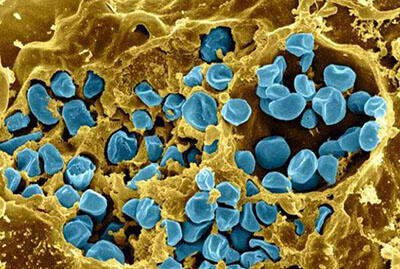
This scanning electron micrograph shows a mouse immune cell (yellow) infected with Francisella tularensis bacteria (blue).
“There is an urgent need to develop a tularemia vaccine that is safe, effective and supported by sufficient data for Food and Drug Administration approval,” said Dr. Joe McDonough, SwRI’s director of Pharmaceuticals and Bioengineering.
The contract will expand on UTSA researcher Dr. Karl Klose’s development of a genetically modified strain of Francisella novicida, a relative of the bacterium that causes tularemia. Klose and his colleagues previously demonstrated that, in vaccine form, it can protect against airborne exposure in animal models.
Typically a tick-borne disease found in animals such as rabbits, tularemia is rare in humans. However, when aerosolized, the bacterium is highly infectious and can cause a potentially fatal infection in the lungs. Classified by the Centers for Disease Control and Prevention as a Category A biothreat agent, it has been developed as an aerosolized bioweapon, posing a threat to national security.
The $18 million contract is a significant accomplishment for the Vaccine Development Center of San Antonio. Founded in 2012 by UTSA, SwRI, Texas Biomedical Research Institute and UT Health San Antonio, the center leverages the strength, expertise and assets of San Antonio’s four leading research institutions to identify and develop promising vaccine candidates to promote public health.
“This program exemplifies the progress that happens when institutions are brought together through partnerships like the Vaccine Development Center of San Antonio,” added McDonough, the center’s scientific co-director. “By combining SwRI’s medical countermeasure development and formulation development experience with Dr. Klose’s and UTSA’s innovation, we will provide a much-needed solution to a critical problem.”
SwRI-Led Lucy Mission has a New Destination
Less than two years before launch, scientists associated with NASA’s Lucy mission have discovered an additional small asteroid that will be visited by the spacecraft. The SwRI-led mission is an ambitious 12-year, 4-billion-mile odyssey to explore the Trojan asteroids, a population of ancient small bodies that share an orbit with Jupiter.

Courtesy of NASA/SwRI
Set to launch in 2021, the first spacecraft to visit the Trojans was already set to break records by visiting seven asteroids during a single mission. Now, using data from the Hubble Space Telescope (HST), the Lucy team discovered that Eurybates, the first Trojan target, has a satellite, providing an additional object for Lucy to study.
“If I had to bet that one of our destinations had a satellite, it would have been this one,” said SwRI’s Hal Levison, principal investigator of the mission. “Eurybates is considered the largest remnant of a giant collision that occurred billions of years ago. Simulations show that asteroid collisions like the one that made Eurybates and its family often produce small satellites.”
Science team members spied a faint spot in a Hubble image of Eurybates. The spot was also in the next set of data, but had moved, just as a satellite would. Although the object was difficult to discern, in part because Eurybates is 6,000 times brighter than its satellite, HST confirmed its existence.
“We then used computer simulations to demonstrate many possible satellite orbits that match both the observations where we can see the satellite, as well as the times when we don’t,” said SwRI’s Cathy Olkin, deputy principal investigator of the Lucy mission. For more information go to: http://lucy.swri.edu To see a video about the Lucy mission, visit: https://youtu.be/4ZHCwSaBzd8.
Evaluating Injector Deposits at Nanoscales
SwRI has adapted a procedure that significantly reduces the time and fuel needed to evaluate the formation of internal deposits on diesel engine fuel injectors. The custom-built injector rig generates deposits that are measured using a variable angle spectroscopic ellipsometer (VASE), a tool typically used by computer engineers to examine film layers in microchips.
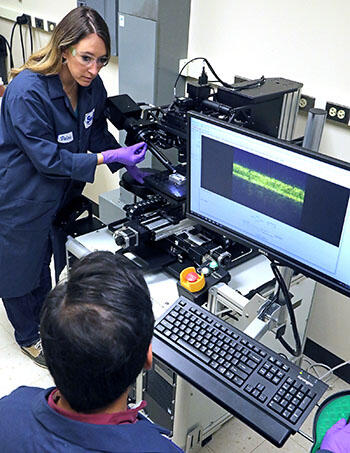
SwRI acquired a VASE tool to develop efficient techniques for measuring deposits in fuel injectors at nanoscales. We plan to adapt VASE technology for other component tests.
SwRI began offering its new, highly accurate internal diesel injector deposit tests in November 2019. For several decades, engineers have used internal diesel injector deposit (IDID) tests to study deposits associated with fuels, additives and contaminants.
“Deposits can slow down or even plug an injector, which can stop the engine from working,” said Doug Yost, staff engineer in SwRI’s Fuels and Lubricants Division. “For many years, the most common IDID test methods involved some combination of full-size engines and test fuels, perhaps doped with excessive levels of additives or contaminants to create deposits that could be characterized with the naked eye. These test conditions did not represent typical engine operations.”
The VASE instrument can detect deposits as thin as 10 nanometers, invisible to the naked eye. The enhanced analytical sensitivity of VASE allows for meaningful deposit data from an IDID rig test run for just seven hours, instead of the hundreds of hours required by the previous methodologies to generate visible deposits, which also saves fuel costs.
Mars' Wild History
Amid the chaos of the early solar system, Mars was likely struck by small protoplanets up to 1,200 miles in diameter as it formed. SwRI scientists modeled the mixing of materials associated with these impacts, revealing that the Red Planet may have formed over a longer timescale than previously thought.
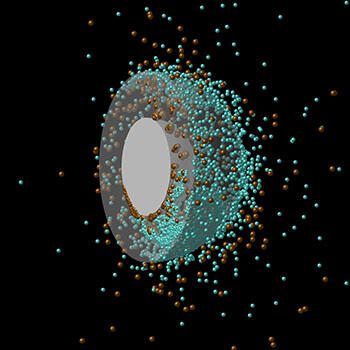
SwRI scientists modeled a large, differentiated projectile hitting early Mars after its core and mantle had formed. The projectile’s core and mantle particles are indicated by brown and green spheres respectively, showing local concentrations of the projectile materials assimilated into the Martian mantle.
“To fully understand Mars, we need to understand the role the earliest and most energetic collisions played in its evolution and composition,” said SwRI’s Dr. Simone Marchi, lead author of a Science Advances paper outlining these results.
Billions of years of history have steadily erased evidence of early impact events. Luckily, some of this evolution is recorded in Martian meteorites. These meteorites exhibit large variations in iron-loving elements, which tend to migrate from a planet’s mantle into its central iron core during formation. Evidence of these elements in the Martian mantle are important because they indicate that Mars was bombarded by planetesimals sometime after its primary core formation ended.

This illustration shows how early Mars may have looked, showing signs of liquid water, large-scale volcanic activity and heavy bombardment from planetary projectiles.
“Collisions by projectiles large enough to have their own cores and mantles could result in a heterogeneous mixture of those materials in the early Martian mantle,” said co-author Dr. Robin Canup, assistant vice president of SwRI’s Space Science and Engineering Division.
Based on the ratio of certain materials in Martian meteorites, it has been argued that Mars grew rapidly within about 2 to 4 million years after the Solar System began to form. However, large early collisions could have altered the ratio, which could support a Mars formation timescale of up to 20 million years, as shown by the new model.
“Based on our model, early collisions produce a heterogeneous, marble-cake-like Martian mantle,” Marchi said. “These results suggest that the prevailing view of Mars formation may be biased by the limited number of meteorites available for study.”
Flow Loop Simulates Pipeline Environment
SwRI now offers a reciprocating compressor flow loop capable of recreating real-life gas pipeline pressures, temperatures and horsepower levels. The flow loop is one of only a handful of its kind available for industry research, development and testing and will play a central role in an ongoing SwRI project to reduce methane emissions.
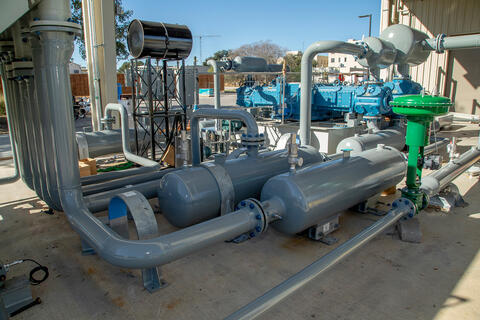
“Most people don’t realize the role compressors play in their everyday lives,” said Dr. Tim Allison, director of SwRI’s Machinery Department. “Natural gas travels through pipelines, meeting a series of compressors every few miles. These devices push gas farther down the pipeline network to its eventual destination, which could be a hot water heater or gas stove at your house.”
The SwRI facility recreates real-world conditions, providing realistic data to evaluate innovations designed to make reciprocating compressors more efficient, reliable and environmentally friendly. While other compressor flow loops exist, SwRI’s is the only one available to anyone in the industry.
Initial research includes efforts to reduce fugitive emissions escaping from natural gas pipelines. Available for client testing since February 2020, future research could include compressor valve testing, advanced pulsation control, drivetrain dynamics studies and lubrication optimization for reciprocating compressors.
Virtual Instrument Enhances Science

Courtesy of NASA/GSFC/SDO
An SwRI scientist used a deep neural network trained to mimic an instrument on the Solar Dynamics Observatory that could infer ultraviolet radiation levels based on what the other SDO instruments observed.
An SwRI scientist participated in a deep learning project that showed it is possible to virtually monitor the Sun’s extreme ultraviolet (EUV) irradiance, a key driver of space weather such as solar flares. These phenomena can affect spacecraft, satellites and even systems on Earth, including GPS navigation, radio communications and the power grid. This virtual “super instrument” can substantially increase the scientific productivity of NASA missions.
“Deep learning is an emerging capability that is revolutionizing the way we interact with data,” said Dr. Andrés Muñoz-Jaramillo, a senior research scientist at SwRI. He is working with collaborators from nine other institutions as part of NASA’s Frontier Development Laboratory, an artificial intelligence research accelerator that applies deep learning and machine learning techniques to challenges in space science and exploration.
The research showed that a deep neural network trained to mimic an instrument on the Solar Dynamics Observatory (SDO) could infer ultraviolet radiation levels based on what the other SDO instruments observed. Muñoz-Jaramillo stressed that these virtual super instruments will not make hardware obsolete. They will always require spacecraft instruments to collect the necessary data for virtualization.
“Deep learning instruments cannot make something out of nothing, but they can significantly enhance the capabilities of existing technology,” he said.
Their virtual super instrument is already in use as part of a Frontier Development Laboratory project to monitor solar sources of space weather. Muñoz-Jaramillo is currently working on a virtual instrument to increase the resolution and sensitivity of historical maps of the solar magnetic field.
UVS Delivered
An ultraviolet spectrograph (UVS) designed and built by SwRI was the first scientific instrument to be delivered for integration onto the European Space Agency’s Jupiter Icy Moon Explorer (JUICE) spacecraft. Scheduled to launch in 2022 and arrive at Jupiter in 2030, JUICE will spend at least three years making detailed observations in the Jovian system before going into orbit around the solar system’s largest moon, Ganymede.
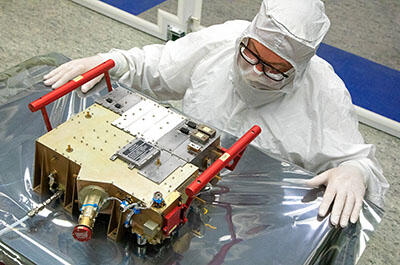
From aboard JUICE, UVS will get close-up views of the Galilean moons Europa, Ganymede and Callisto. UVS will record ultraviolet light emitted, transmitted and reflected by these bodies, all thought to host liquid water beneath their icy surfaces. These measurements will reveal the composition of their surfaces and tenuous atmospheres as well as their interactions with Jupiter and its giant magnetosphere.
“In 2013, NASA selected UVS for the first ESA-led mission to an outer planet,” said Steven Persyn, project manager for JUICE-UVS and an assistant director in SwRI’s Space Science and Engineering Division. “Meeting both NASA’s and ESA’s specifications was challenging, but we did it.”
UVS will be one of 10 science instruments and 11 investigations for the JUICE mission. The mission has overarching goals of investigating potentially habitable worlds around the gas giant as well as studying the Jupiter system as an archetype for gas giants in our solar system and beyond.
“JUICE-UVS is the fifth in a series of SwRI-built ultraviolet spectrographs, and it benefits greatly from the design experience gained by our team from the Juno-UVS instrument, which is currently operating in Jupiter’s harsh radiation environment,” Persyn said. “Each successive instrument we build is more capable than its predecessor.”
Predicting Pedestrian Paths
As a leading innovator of machine learning technologies, SwRI has developed a system to help automated vehicles detect pedestrians. The computer vision tool uses a novel biomechanical deep learning algorithm that predicts a pedestrian’s path as indicated by movement of the person’s pelvis.
“If a pedestrian is walking west, the system can predict if that person will suddenly turn south,” said SwRI’s Samuel E. Slocum, a senior research analyst who led the internally funded project. “As the push for automated vehicles accelerates, this research offers several important safety features to help protect pedestrians.”

SwRI’s human motion prediction system overlays sparse skeletal features on pedestrians to predict movement. Deep learning algorithms predict motion based on pelvic biomechanical movement, as indicated by blue dot.
Recent accidents involving automated vehicles have heightened the call for improved detection of pedestrians and other moving obstacles. Although previous technologies could track and predict movements in a straight line, they were unable to anticipate sudden changes.
Motion prediction often uses algorithms based on “optical flow,” a type of computer vision that pairs algorithms with cameras to track dynamic objects. Its accuracy diminishes, however, when people move in unexpected directions.
SwRI compared optical flow to other deep learning methods, including temporal convolutional networks (TCNs) and long short-term memory (LSTM). After testing several configurations, researchers optimized a novel TCN that outperformed competing algorithms, predicting sudden changes in motion within milliseconds with a high level of accuracy.
SwRI’s research is a small step for autonomous systems to react more like human drivers. “If we see a pedestrian, we might prepare to slow down or change lanes in anticipation of someone crossing the street,” said Dr. Douglas Brooks, a manager in SwRI’s Applied Sensing Department. “We take it for granted, but it’s incredibly complex for a computer to process this scene and predict scenarios.”
Applications include human performance, automated vehicles and manufacturing robotics. The algorithms can work with a variety of camera-based systems. Datasets are available to SwRI clients.
Enceladus Inside Out
A new SwRI-developed geochemical model reveals that carbon dioxide (CO2) from within Enceladus, an ocean-harboring moon of Saturn, may be controlled by chemical reactions at the seafloor of Enceladus. Studying the plume of gases and frozen sea spray released through cracks in the moon’s icy surface suggests an interior more complex than previously thought.
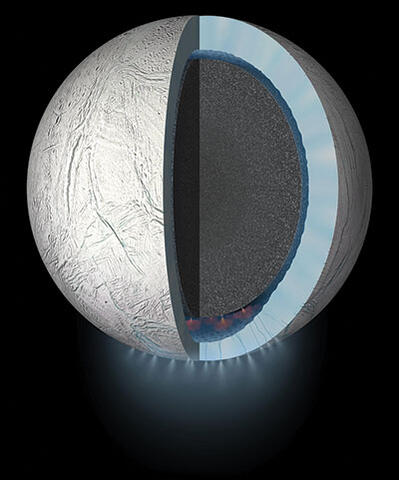
Courtesy of NASA/JPL-CALTECH
“By understanding the composition of the plume, we can learn about what the ocean is like, how it got to be this way and whether it provides environments where life as we know it could survive,” said SwRI’s Dr. Christopher Glein, lead author of a paper in Geophysical Research Letters outlining the research. “We came up with a new technique for analyzing the plume composition to estimate the concentration of dissolved CO2 in the ocean. This enabled modeling to probe deeper interior processes.”
Analysis of mass spectrometry data from NASA’s Cassini spacecraft indicates that the abundance of CO2 is best explained by geochemical reactions between the moon’s rocky core and liquid water from its subsurface ocean. Integrating this information with previous discoveries of silica (SiO2) and molecular hydrogen (H2) points to a more complex, geochemically diverse core. Another phenomenon that contributes to this complexity is the likely presence of hydrothermal vents inside Enceladus. At Earth’s ocean floor, hydrothermal vents emit hot, energy-rich, mineral-laden fluids that allow unique ecosystems teeming with unusual creatures to thrive.
“The dynamic interface of a complex core and seawater could potentially create energy sources that might support life,” said SwRI’s Dr. Hunter Waite, principal investigator of Cassini’s Ion Neutral Mass Spectrometer (INMS). “While we have not found evidence of the presence of microbial life in the ocean of Enceladus, the growing evidence for chemical disequilibrium offers a tantalizing hint that habitable conditions could exist beneath the moon’s icy crust.”
Stratospheric Science Platform
An SwRI team successfully demonstrated the SwRI Solar Instrument Pointing Platform (SSIPP), a miniature solar observatory, on a high-altitude balloon. The reusable, high-precision platform weighs 160 pounds and was carried aloft by a stratospheric balloon, collecting 75 minutes of solar images in the proof-of-concept flight.
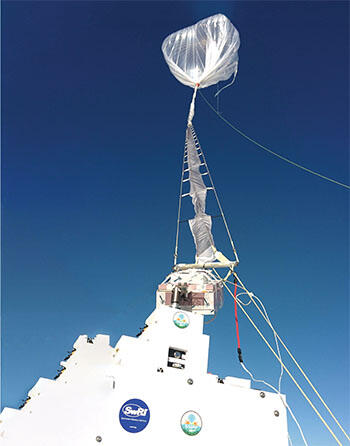
“SSIPP is a novel, low-cost observatory prototype,” said SwRI’s Dr. Craig DeForest, principal investigator of the NASA Flight Opportunities mission. “We are working to provide similar infrastructure and flexibility to a ground-based observatory, delivered to near-space.”
SSIPP collects solar data using infrared, ultraviolet or visible light instruments on an optical table, similar to those used in groundbased observatories, but from a near-space environment. SSIPP is an arcsecond-class observatory, which provides optical precision equivalent to imaging a dime from a mile away. The platform supports the development of custom solar instruments. Collecting data from the edge of space — around 20 miles above the Earth’s surface — avoids image distortions caused by looking through the atmosphere.
“SSIPP could support the development of a range of new instruments for the near-space environment at relatively low cost,” DeForest said. SSIPP includes an “optical table,” a stable platform used to support optics in a laboratory environment. “Using a standard optical table platform increases flexibility, allowing scientists to develop new technologies without designing a custom observatory.”
Because existing spaceborne assets are optimized for different science, the wavelength range observed by SSIPP fills a gap in current measurements, highlighting the importance of new instruments to advance knowledge.
“Upon reaching the stratosphere, SSIPP immediately locked onto the solar disk using a novel two-stage pointing system,” said SwRI Principal Analyst Dr. Glenn Laurent. “The next step for SSIPP is to partner with outside institutions to extend quick-turnaround solar flights to a range of scientific instrumentation.”

